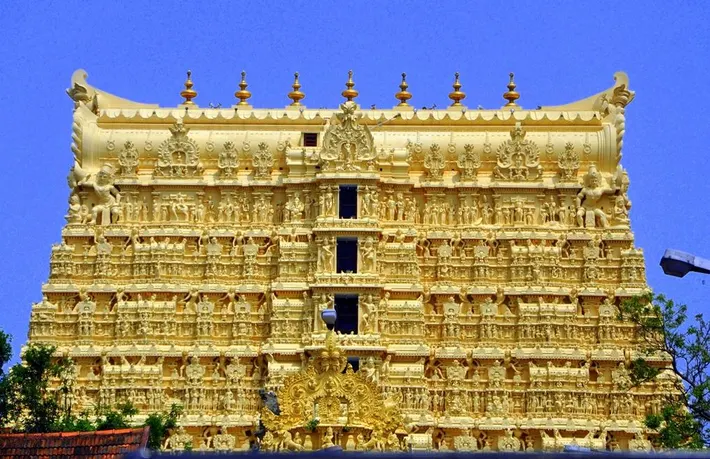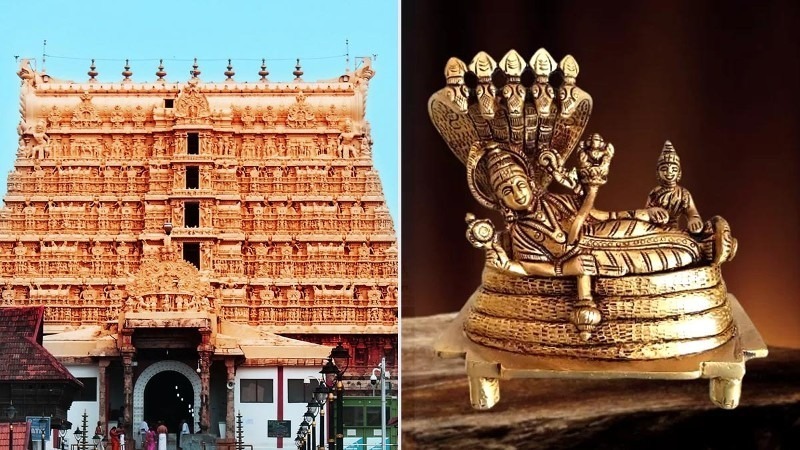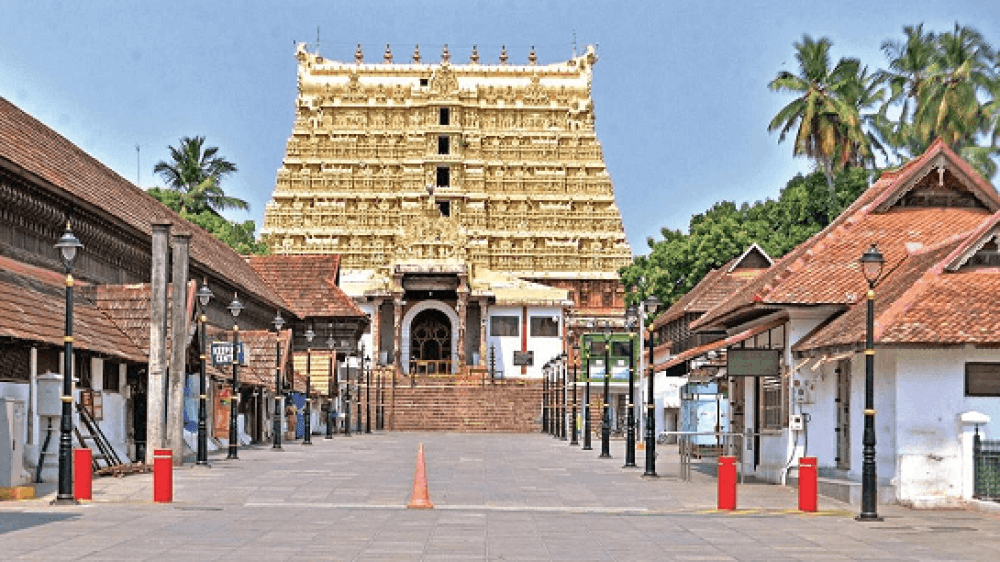
Padmanabhaswamy Temple
Believed to have originated in the eighth century, the temple is part of the 108 Vishnu temples in India. The main deity is in the Ananthashayana posture, reclining on Adisesha, the serpent god.
The Sree Padmanabhaswamy Temple in Thiruvananthapuram is considered one of the wealthiest shrines globally, holding six vaults filled with a vast amount of valuable items like precious stones, gold, and silver. The exact value of these treasures remains unknown. The temple has a mysterious and ancient history, leading to various stories about its valuable collection. Even with one vault still sealed, the temple remains a popular destination for visitors due to its reputation as the abode of Lord Padmanabha.
Namaste 🙏 नमस्ते
Secure your visit • अपनी यात्रा सुरक्षित करें
Historical background and Architectural splendor
The Padmanabhaswamy Temple holds a rich historical background dating back to antiquity. Built in the Dravidian architectural style, the temple is a testament to the deep-rooted religious and cultural traditions of the region. Its origins are intertwined with the medieval history of Travancore, where the rulers played a pivotal role in fostering the growth and prominence of the temple. Over the centuries, the temple has witnessed various renovations and enhancements, each contributing to its present-day grandeur.
The architectural splendor of the Padmanabhaswamy Temple is a captivating blend of Dravidian and Kerala styles, showcasing meticulous craftsmanship and artistic finesse. The towering Gopuram at the entrance, adorned with detailed carvings, welcomes visitors into a sacred space of divine reverence. The temple’s interiors feature elaborately carved pillars, distinctive mandapams narrating epic stories, and a stunning Dravidian tower over the sanctum where Lord Padmanabhaswamy rests in a yogic sleep posture on the serpent Anantha. With its corridors, halls, and outer walls adorned with sculptures depicting Hindu mythology, the Padmanabhaswamy Temple stands as a magnificent testament to the cultural heritage and architectural prowess of the region.

Festival and Celebrations
The Painkuni Festival at Sree Padmanabha Swamy Temple starts with the kodiyettu, hoisting the ceremonial flag in March/April. The ten-day celebration features fiberglass figures of the Pandavas at the temple's eastern entrance, symbolically pleasing Indra, the Rain God. The festival includes daily rituals, climaxing on the ninth day with the royal family's palli vetta near Vettakorumakan Temple. It concludes with a grand aarattu procession to Shanghumugham Beach on the tenth day, where the idols are ritually immersed in the sea. The Royal Family of Travancore, led by the king, escorts the deities, adding a regal touch to the festival's vibrant finale.
Religious Significance
The Padmanabhaswamy Temple, with its roots tracing back to antiquity, stands as an architectural marvel in the Dravidian style, embodying the deep-seated religious and cultural ethos of Travancore. Through centuries, it has been meticulously renovated, each enhancement adding to its majestic allure. The temple’s architectural splendor, a fusion of Dravidian and Kerala styles, is a testament to exquisite craftsmanship and artistic prowess. Adorned with detailed carvings, the towering Gopuram beckons visitors into a realm of divine reverence. Within, elaborately carved pillars, storytelling mandapams, and a striking Dravidian tower housing Lord Padmanabhaswamy in yogic repose atop the serpent Anantha, narrate tales of Hindu mythology. The temple’s corridors and outer walls, embellished with sculptures, further enrich its magnificence, epitomizing the rich cultural heritage and architectural brilliance of the region.

Surroundings area & attractions
- Kuthira Malika (Puthen Malika) Palace: A palace built by Swathi Thirunal Rama Varma, the Maharaja of Travancore, known for its architectural beauty and the collection of horse artifacts.
- Attukal Bhagavathy Temple: Known for the annual Pongala festival, it's one of the prominent temples dedicated to the goddess Bhagavathy.
Visitor information
Entry Fee:
- 150 per person for Special Darshan
- 180 per person for Special Darshan with Prashad
Sree Padmanabhaswamy Temple Darshan Timings in Morning:
- 3:15 am to 4:15 am
- 6:30 am to 7:00 am
- 8.30 am to 10:00 am
- 8.30 am to 10:00 am
- 11:45 am to 12:00 pm
Evening Darshan Timings of Sri Padmanabha Swamy Temple:
- 5:00 pm to 6:15 pm
- 6:45 pm to 7:20 pm
Address:
W Nada, East Fort, Pazhavangadi, Thiruvananthapuram, Kerala, 695023, India
Notable Events and Incidents
- Vault Discoveries: The temple gained international attention in 2011 when the discovery of hidden underground vaults was made.
- Annual Festivals: The temple comes alive during Navratri with rituals, processions, and cultural events, attracting devotees from far and wide.
Connectivity:
- By Air: The nearest airport to Sree Padmanabhaswamy Temple is Trivandrum International Airport, located about 6 kilometers away. From the airport, visitors can hire taxis, autos, or app-based cabs to reach the temple comfortably.
- By Rail: The nearest railway station is Thiruvananthapuram Central (TVC), situated approximately 1 kilometer from the temple. From the station, one can easily hire autos, taxis, or take local buses to reach the temple premises.
- By Road: Thiruvananthapuram city is well-connected by road to major towns and cities across Kerala and neighboring states. The temple is easily reachable from any part of the city through KSRTC buses, autos, and taxis, with smooth access from NH66 and MC Road.
FAQ
The Padmanabhaswamy Temple is located in Thiruvananthapuram, the capital city of Kerala,
India.
The temple is renowned for its architectural beauty, religious significance, and historical importance. It is one of the 108 Divya Desams (sacred abodes of Lord Vishnu) and is considered one of the wealthiest religious institutions in the world due to the treasures discovered within its vaults.
The presiding deity is Lord Padmanabhaswamy, a form of Lord Vishnu reclining on the serpent Anantha (Adi Sesha).
The temple architecture follows the Dravidian style and is known for its intricate carvings, towering gopurams (entrance towers), and vast corridors. The sanctum sanctorum, where the deity is enshrined, is accessible only to Hindus and follows strict dress code and customs.
In 2011, vaults beneath the temple were opened, revealing a vast treasure trove of gold, jewels, and other valuable artifacts. This discovery catapulted the temple into global headlines and raised questions about its wealth and management.
No, the treasure discovered in the temple vaults is not accessible to the public. It is under the administration of a trust appointed by the Supreme Court of India.
The temple celebrates various festivals throughout the year, including Navaratri, Panguni Uthiram, Vishu, and the Alpashy festival. The annual 10-day festival called “Alpashy Utsavam” is particularly grand, featuring colorful processions, music, dance, and rituals.
The temple is open to devotees and visitors from early morning till late evening. However, specific timings may vary on festival days and during special occasions.
Yes, there is a strict dress code enforced at the Padmanabhaswamy Temple. Men are required to wear traditional attire like dhoti or mundu without shirts, while women should wear traditional Indian attire like saree or salwar kameez.
No, photography is strictly prohibited inside the temple premises to maintain its sanctity and preserve the religious atmosphere.
The temple’s history dates back several centuries, with records suggesting its existence since at least the 8th century CE. It underwent significant renovations and expansions over the years under various rulers and patrons, including the Travancore Royal Family.
Devotees believe that Lord Padmanabhaswamy is a form of Lord Vishnu and worship him for blessings, protection, and salvation. The deity is often depicted reclining on the serpent Anantha, symbolizing eternity.
Yes, the temple conducts several rituals and poojas daily, including the morning and evening darshan (viewing) of the deity, Abhishekam (ritual bathing of the idol), Utsavams (festivals), and various offerings made by devotees
Devotees typically offer prayers by standing in queue lines, approaching the sanctum sanctorum, and making offerings such as flowers, coconuts, and other items. There are also opportunities for devotees to perform special poojas and rituals by prior appointment.
Apart from the main sanctum sanctorum, the temple complex houses several other shrines dedicated to various deities, including Lord Narasimha, Lord Krishna, and Goddess Lakshmi. The temple tank, known as Padma Theertham, is also considered sacred.
The temple is located in the heart of Thiruvananthapuram city and is easily accessible by road. The nearest railway station is Thiruvananthapuram Central, and the nearest airport is Trivandrum International Airport. Local transportation options such as taxis, auto-rickshaws, and buses are available.
No, there is no entry fee to visit the temple. However, donations are accepted for temple maintenance and development.
Yes, there are various hotels, guesthouses, and lodges available in Thiruvananthapuram city to suit different budgets and preferences. Additionally, the temple administration may provide accommodation facilities for devotees upon prior arrangements.
Thiruvananthapuram offers several other attractions for visitors, including the Napier Museum, Kuthiramalika Palace, Sri Chitra Art Gallery, and the scenic beaches of Kovalam and Varkala.
The temple welcomes visitors throughout the year, but some may prefer to visit during festivals or special occasions to experience the vibrant atmosphere and cultural festivities.
